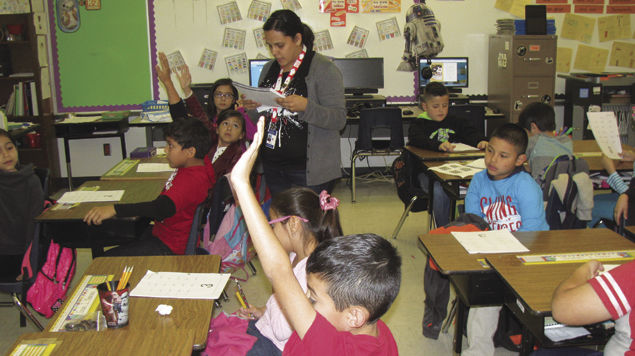HARLINGEN — “Three, speed, see. Which sound is the same in all the words?”
Nadia Lugo had written the words, which included street and tree, for her second graders to see.
“Eeee!” they said.
The students at Sam Houston Elementary were dissecting, or “decoding,” words into their individual parts. The two letters making up the same sound were “digraphs”, a word they seemed to know quite well.
It’s all part of a program from Neuhaus Education Center called Accurate and Automatic Decoding. The program is a new initiative begun by the district this school year and it’s helping young readers move more quickly into the world of words.
“Phonics can be taught different ways,” said Ginger Armstrong, principal at Sam Houston.
“You can teach it as it comes about when you’re teaching reading,” she said. “Research shows the most effective way for struggling beginning readers is systematic direct instruction.”
This method, she said, teaches letter-sound relationships, such as the sound indicated by the “ph” combination, the hard “t” sound, or “shhhhhh.”
This enables them to put sounds together to form words.
“I think that it really gives them the tools they need to be able to decode words,” she said. “Reading is a lot less laborious if students understand how letters go together and make words.”
Back in Lugo’s class, the children weren’t finished dissecting words. She’d handed out sheets with more words containing the “ee” sound.
“Deep, green,” she said. “What is the medial sound?”
Hands shot up.
“Eee” they said. It was the same answer — the right answer — for two questions. The medial sound was the middle sound.
The new program is definitely making a difference, said Christine Claudio who is also teaching phonics through the new method.
“As teachers our goal is to have kids on reading level with their grade,” Claudio said. “In order for that to happen it’s critical they have comprehension.”
Too often, she said, children can read but if you ask them questions about the material they can’t answer. They were too focused on decoding the words. The new phonics program facilitates that.
Another part of decoding is the study of suffixes such as “ful.”
“We give them six words with ‘ful’ like thankful, thoughtful,” she said. “You have the base word and the suffix. What rhymes with thankful?”
Words can often be a confusing jungle of soft vowels, hard consonants, and an endless array of connections between both. Add to that the multiple meanings of each word and it can be a headache for anybody.
This new program helps give some rhyme and reason to this confounding maze and turn it into a vital tool.




